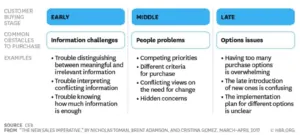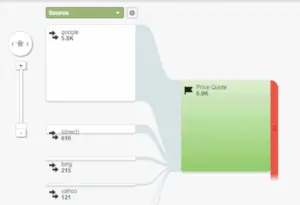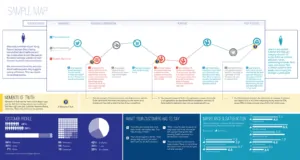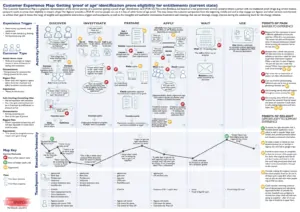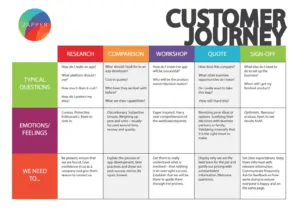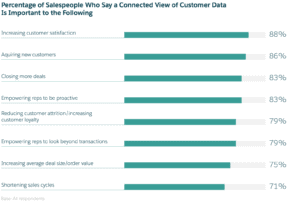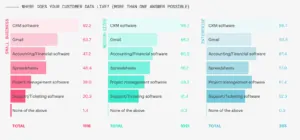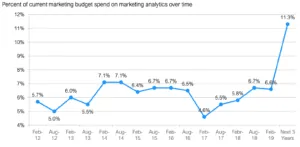Customer journey maps are typically considered “marketing stuff.” Which, let’s just come out and say it, is weird, right?
Sales reps interact directly with customers, yet, often don’t have a clear understanding of how the people they talk to actually experience the brand across various channels and touchpoints.
The reality is—in this one-to-one relationship selling era, customer journey mapping should start with sales.
Sales has the data and that front-line access to customers, which of course, provides more context than a slap-dash persona and a Google Analytics account.
In this article, we’ll go over some key things that reps need to know mapping the customer journey and why it matters.
What is a customer journey map and where does sales fit in?
A customer journey map outlines all the interactions leads, prospects, and customers have with your brand and how they feel about your brand during each interaction. The idea is to reveal where in the customer experience prospects move forward in the sales funnel, stall out, or drop off.
By monitoring and mapping customer movements, you’ll learn a lot more about your prospects’ than where they click on a website. A few examples of what you can learn:
- Preferences
- Feelings
- Pain points
- Challenges
- Goals
- Expectations
- Dislikes
- Decision-making factors
Okay, so why should sales care about customer journey mapping, anyway? Well–those bullet points are just scratching the surface, but understanding the “why” behind every webinar sign up and free trial registration is probably pretty important if you’re trying to convince someone to sign a contract.
A detailed map can reveal what factors contributed to closing a deal or losing a customer–which of course can be used to fine-tune your selling strategy.
It’s also worth pointing out, problems like bad leads and message mismatch can wreak havoc on the funnel from the get-go.
For example, if a marketing team creates personas and maps without sales’ input, there’s a chance that the whole sales cycle begins by targeting the wrong people.
That disconnect means that neither sales nor marketing really “gets” what their customers want and they’re left-leaning on gut feelings, making guesses about what personas like Marketing Molly or Real Estate Randy might do if they were actual people.
This graphic highlights a few problems that might emerge early, middle, and late in the journey.
In the old days of marketing and sales, customer journeys were relatively linear. You could meet people in person or talk on the phone. You might book a couple of follow-ups to seal the deal, but could chart out a journey from point A to B.
Now, buyers do their own research and bounce around between Google searches and social channels, e-books, and emails.
Because you’re trying to learn about literally dozens of variables at once, a company’s best chances of understanding their audience is making mapping a team effort.
ID those touchpoints (wait, can you?)
Customer journey mapping allows you to connect the points of interaction that your customer has with your brand, or outside of your brand, as they seek to meet their specific goals and needs.
If you’re not sure where to start looking for touchpoints, look toward Google Analytics and check out the behavior flow report and the goal flow report.
Behavior Flow will reveal how visitors navigate through your site, revealing where they lose interest or get stuck.
Goal Flow will reveal whether your visitors complete the desired goal.
It should feature markers for each touchpoint and areas where your company can change things for the better.
Typically, mapping follows this series of steps:
- Establish a clear set of objectives for your map.
- Look at personas and identify their goals.
- List all touchpoints.
- Identify what should be included in the map.
- Walk through the journey yourself and look for opportunities to improve.
Customer journey sales-style
In this sample map–you’ll notice a few things happening. The map is built around persona, Jane and broken into four distinct phases. As she moves from Awareness to Purchase and Post-Purchase, she experiences a blend of highs and lows.
In this case, Jane was impressed by this company’s Twitter presence, they responded quickly, prompting her to move into the consideration phase. Once there, it looks like she had some trouble finding what she needed.
While one company can have way more touch points than this, here are some “standard” ones you can start with:
1. Your website
2. Your outbound marketing
3. Your sales team
4. Your customer support team
5. Your major brand presence on owned channels—owned channels include social media platforms like LinkedIn, Facebook, and Twitter, as well as YouTube or review sites—in other words, any public profiles your company uses to reach customers.
In all, your customer will experience an emotional rollercoaster as they move through the sales cycle. As a sales rep, your role in the customer journey mapping is all about gathering that frontline intelligence. Where might someone like Jane become frustrated during the buying cycle?
CX consultant, Mitch Belsley recommends simplifying customer journeys into an experience storyboard. What Belsley is getting at is this idea of creating a simplified visualization that anyone in the organization can quickly grasp.
So, you might have a complex version of the map that looks like this:
Pretty chaotic, right? Um. yeah. As such, a customer journey map template like this one from Dapper Apps breaks things down in a more approachable way for sales teams.
Customer journey maps depend on connected data.
Per Salesforce research, a connected view of all customer data lays the groundwork for all of this mapping business.
As executive leadership focuses on delighting customers, sales teams are beginning to recognize that connected experiences entail far more than sales interactions. Meaning, there’s a real push toward including sales teams in the mapping process. Think about how what’s in your CRM alone brings more context to those Analytics reports mentioned above–and that’s not even the full picture.
On the buyer side, 75% of surveyed buyers said connectivity between marketing, sales, and service teams are very important to winning their business. And–77% of salespeople feel the same way.
The idea is, collaborative selling methods like account-based marketing, brings in multiple views of the customer experience.
Traditionally, marketing gathers the leads first and passes qualified leads to sales. Marketing teams have a view of which methods attract people to the business and how they respond to things like Instagram campaigns or that new lead gen strategy on YouTube.
Sales reps, by contrast, talk to people after they’ve interacted with your marketing materials. The former gets a zoomed-out view powered by analytics, whereas the latter gets up close and personal with prospects and can offer more insights on an individual level.
Outside of sales and marketing, you’ll have technical support folks and customer service reps that handle day-to-day questions and concerns.
While 81% of those surveyed by Salesforce say that access to customer data is important to them, this connected, collaborative approach depends on using the right tools; recording customer interactions in the CRM and collecting insights from other channels like review sites, social media, and email records.
You’ll also find customer data hanging out in accounting programs, project management apps, support desk software, and more.
Analytical meets anecdotal.
On the marketing side, these guys have analytics on lock. Per CMO Survey, marketing teams use analytics to power decision-making 43% of the time.
Marketing insights reveal things like what customers are looking for on your website, which pages get them to move further down the funnel and which cause them to abandon ship. On social, marketing teams can learn which posts drive the most engagement, which times people are more active online, the list goes on.
What doesn’t come into play here is the “why” behind these patterns. And that’s where sales comes in–filling in the blanks with the anecdotal evidence.
So, okay, let’s think anecdotal. As a sales rep, your role in the customer journey often involves comparing the information gathered from individual customers to the zoomed-out behavioral data that marketing collects through various platforms. Meaning–how does what someone says square with what they do?
Collect this information by asking more questions during sales calls, in your emails. Look out for how people respond to your messaging.
- Are there common pain points among your customers?
- What objections come up over and over?
- Are you seeing any shifts in the market that aren’t reflected in how your company views this persona?
Work with marketing to deliver content tailored to each stage and persona.
Let’s talk about collaboration again. Marketing teams are likely working hard to deliver content that connects with their audience at every stage in the journey. But, the challenge for them is, they don’t have access to that anecdotal stuff salespeople hear every day.
With that in mind, here are a few questions that can help you understand where opportunities exist in the journey:
- Is there any friction in the flow?
- Is it clear what needs to happen to take the next step?
- Is there anything confusing about the customer experience at this stage?
- What can be done to remove any existing barriers moving forward?
Walk through this process with marketing–and fill them in on what customers are saying. Are there key concepts that haven’t been addressed in your blog or knowledge base? Is your free trial sign-up sheet too long?
Use sales account mapping to connect markers to the money.
Often, salespeople get caught up in metrics like deals closed, calls made, or emails sent. Which while important, don’t really amount to providing the customer with anything of value.
Sales reps might believe CX, journey mapping, and personas are useful, but it’s sometimes hard to picture how those elements are directly connected to profits. Though, per Temkin Group research, a good experience leads to major $$$.
To improve the customer experience, you’ll need to understand the impact of each touchpoint. For example, how does offering more information during the consideration stage speed up the sales cycle? How might providing pricing information on your website lead to more requests for a quote?
To make this touchpoint to outcome mapping a bit easier, you might try using the “jobs to be done framework” to build a selling strategy around each stage in the journey.
Jobs to be done, or JTBD, is based on this idea that people “hire” products to do jobs for them. So, your job is to highlight your product’s “qualifications” to seal the deal. In this case, you might ask the following questions at each stage:
- What is this person’s goal?
- What emotional and logical criteria must be met to accomplish this goal?
- What can you do to help that person reach that goal?
- What supporting resources does this person expect to find along the way?
Bottom line: journey mapping depends on sales.
It’s easy to forget that you’re dealing with real people and real emotions when you’re looking at composite personas and a bunch of data points. Sales’ role in customer journey mapping is all about fleshing out the big-picture insights provided by marketing with real questions, complaints, and objectives.
That said, none of this mapping stuff is possible without data. Your CRM should connect with your customer engagement tool, accounting software, social media, and whatever else you use to power your sales process.
For more ways to take customer data and turn it into action, take Revenue Grid for a spin.
